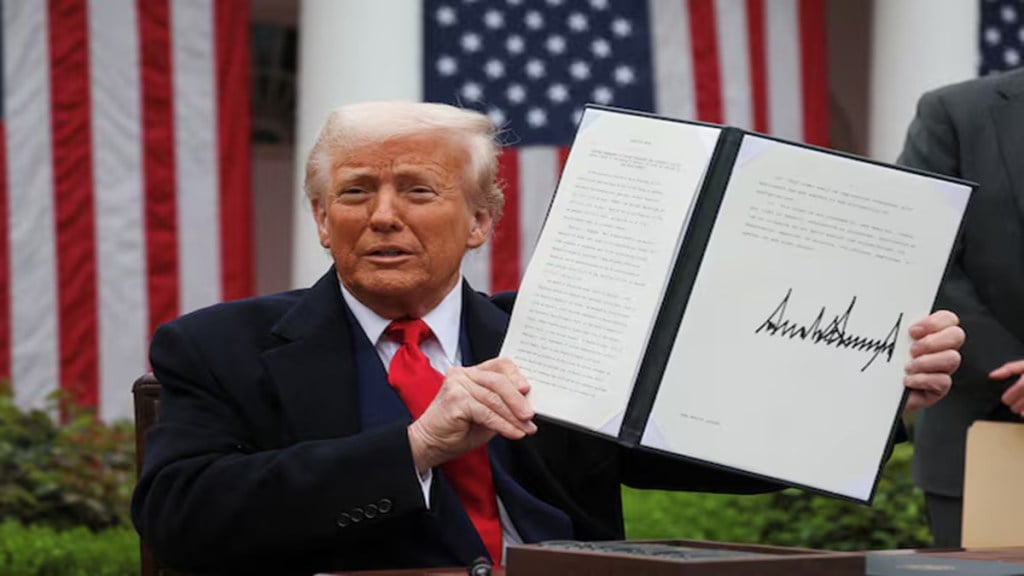By Amitendu Palit
The latest twist in the US reciprocal tariff tale is a 90-day pause, ostensibly for allowing countries to negotiate individually with the US for adjusting their own tariffs and trade barriers. But there’s much more to it. The announcement to pause reciprocal tariffs on the day from which the baseline plus rates on several countries were to become effective shows the anxieties affecting the US strategy of achieving national interests through tariffs.
Reciprocal tariffs can be traced back to the first executive order that US President Donald Trump issued after assuming office in his second term. The order emphasised the Trump administration’s intent to address national security risks arising from large trade deficits and “recommend appropriate measures, such as a global supplemental tariff or other policies, to remedy such deficits”.
The tariffs subsequently announced on April 2 outlined the background of a national emergency for justifying their imposition. The emergency was concerning security risks arising for the US from large trade deficits with several countries that has made it critically dependent on various imports. The dependence, as further explained, was due to the lack of reciprocity in trade relations between the US and its partners, embodied in various partner-country practices, including tariffs on US goods and other non-tariff market access barriers. Reciprocal tariffs were therefore declared to be imposed on almost all trade partners at a rate of 10%, with rates being much higher for countries that were identified as having larger trade barriers.
In the above context, the subsequent pause on these tariffs raises some questions.
The first question is related to the context of the national emergency that the executive order painstakingly elaborated for justifying reciprocal tariffs. This has remained unchanged as the US trade deficits continue. If reciprocal tariffs were meant to correct these, then why were they halted?
The second question that comes up is, why didn’t the US announce a 90-day period for implementing the tariffs right at the beginning, and why was the pause brought in right when they were to go into effect? If one of the purposes behind the tariffs was to bring the “errant” trade partners to the table for negotiating market access with the US, then it could have been easily done within a priorly-announced 90-day period.
Another question that comes up is, would the tariffs have been halted if global stock markets had not lost almost $100 billion after their announcement and the spectre of a global recession had not become as alarming as it has?
The questions underpin the limitations of using tariffs for correcting the imbalances in the US’ global trade relations, which arose from purely economic and structural reasons. They also demonstrate the unwillingness of global markets, investors, and businesses to accept the use of tariffs in reforming the un-reformable.
The pause has been driven by fundamental anxieties surrounding these questions and the realisation that the economic and financial turbulence caused by the tariffs are going to hit the US hard. Indeed, the impact of the hit is going to be much more than temporary short-term pains.
If the tariffs are implemented, whenever they are, they will increase the cost of goods bought by US consumers. These costlier goods will pinch them hard if their incomes don’t increase. There is no immediate possibility of a rise in consumer incomes.
American businesses are unlikely to rush back home immediately for relocating production, especially when the cost of producing at home is exceptionally high due to the tariffs put on inputs sourced from outside the US. If US businesses don’t come back, then domestic jobs are not going to grow. In any case, jobs won’t be created by the return of businesses alone, given the automations that labour-intensive production has undergone.
So where does that leave the US consumer? At the mercy of federal income tax cuts for retaining purchasing powers that can enable the purchase of costlier imported goods. The income tax cuts will depend on the revenues that the tariffs fetch, as overall revenues for the treasury must remain intact. The revenue estimates from tariffs are based on the assumption that imports to the US will remain unchanged. But will they?
The US share in the global goods trade is roughly around 12%. There’s a huge world of trade outside this proportion. An immediate impact of the tariffs will be the diversion of exports from the US market. Such a diversion is already being formalised through various bilateral agreements that countries are working out among each other.
Furthermore, even if countries come to bilateral preferential trade agreements with the US, projected revenues from tariffs will fall then too. The lower revenues are unlikely to be compensated by greater export earnings. Several US products such as electric vehicles and bourbon whisky are unlikely to be lapped up by markets even at lower tariffs.
With domestic consumers hard-pressed to manage needs and businesses struggling to adapt to rising costs of functioning in the US, an economic contraction is inevitable. Once the contraction hits, the short-term pain can become chronic. It can have major ripple effects going up to the mid-term elections to be held in 2026.
The pause was therefore inevitable. In the entire tariff saga that has unfolded since President Trump assumed office in January, pauses have been frequent and never far between. The question that now looms large is whether the US will risk the economic costs of following through with the tariffs at all, because that might mean much greater economic insecurity and hardship than what the national emergency narrative of trade deficits indicates.
The writer is senior research fellow and research lead (trade and economics), Institute of South Asian Studies, National University of Singapore.
Disclaimer: Views expressed are personal and do not reflect the official position or policy of FinancialExpress.com. Reproducing this content without permission is prohibited.


